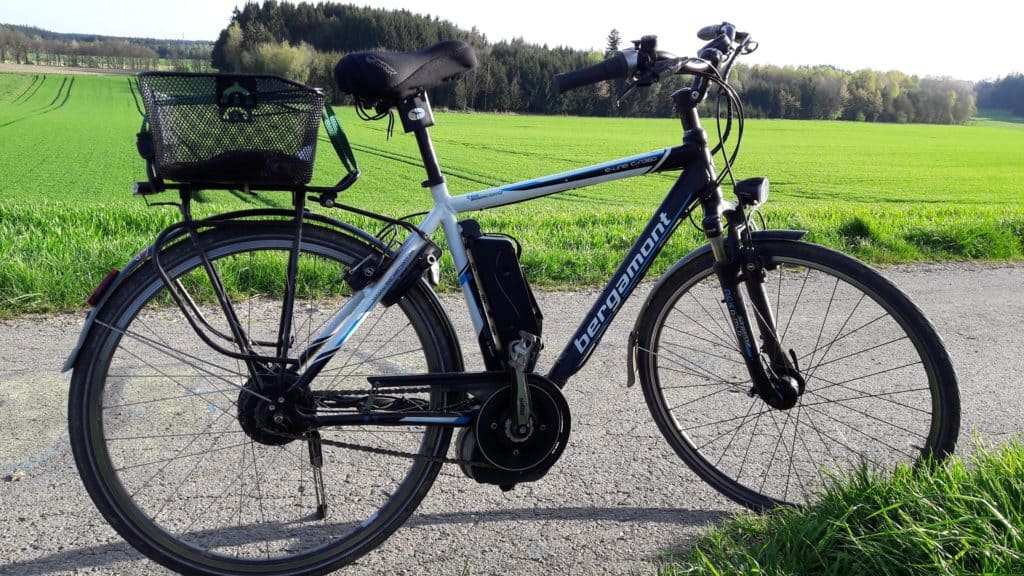This post may contain affiliate links. If you click an affiliate link and make a purchase, I may earn a commission. Also, as an Amazon Associate, I earn from qualifying purchases.--
If you have an electric bike, you’ve likely realized how invaluable it has become on your commutes. Even if you simply own an electric bike for leisure, you know full well that it will not work unless the electric bike battery is properly charged.
How to charge an electric bike:
- Remove the battery pack from the e-bike.
- Turn the battery switch off.
- Connect your charger to the battery pack.
- Plugin the charger that came with your bike into a mains outlet.
- Turn on the plug to begin charging.
It should be noted that some electric bikes allow you to keep the battery on your bike and charge from there.
It seems simple enough; however, like most of our electronic items these days, there are ways to optimize battery life as well as improve the overall lifespan of the battery itself. There are a number of factors to be considered beyond simply plugging and unplugging your battery pack.

The Basics of an Electric Bike Battery
The basic principles required to charge the battery on an electric bike will be relatively universal, while each manufacturer will have slight nuances and differences.
When you first get an electric bike, take the time to read through care instructions provided by the manufacturer to ensure that you are getting the most out of your bike’s life.
Charging Equipment
When you first get your electric bike, there will be charging equipment included. Your specific bike will have instructions to identify how to use and charge your bike. Charging equipment you can expect will be:
- Battery pack with the bike battery inside
- Battery bay to connect the bike to the battery
- Charger consisting of the power supply with two slots
- Two cables to connect to the power supply

When to Charge Your Electric Bike Battery
The majority of electric bikes will have light indicators to tell you whether your bike needs charging or if your bike is now fully charged. When your bike runs out of power or the battery is getting low, the light will turn red, and when the battery is done charging, the light will turn green.
For the majority of electric bike models, the indicator light on the battery will blink in some fashion while it is being charged.
Once the red light indicator has illuminated, you will need to remove the battery from the bike bay. Be sure to turn the battery off before you connect it to the power supply. The power supply itself will then need to be attached to the mains outlet.
After it has charged for the appropriate amount of time, which will vary according to the bike, the light will turn green, and you can reattach it to your bike’s battery bay.
Depending on the brand of electric bike you own it can take anywhere between 2 to 7 hours to fully charge the battery. It should also be noted that for most of the time you won’t need to charge your battery after every single ride.
Ways to Improve Battery Life
While the act of charging your electric bike’s battery is relatively simple, there are some do’s and don’ts to consider in order to improve the overall life of the battery. Major things to keep in mind when charging your battery include:
- Don’t charge a battery for longer than 12 hours
- The battery will last longer if you keep it between 20% and 80%.
- Be sure to charge your battery on a regular basis
- Do not let the battery get too cold or too hot (50°F –77°F // 10°C–25°C).
- Don’t charge the battery for too long
- Do not store your battery when it is empty
- Store your battery on a flat, hard surface
- Make sure battery is clean from dirt, grime, or water
Charge Brand New Battery for Proper Time
When you first get your electric bike, the battery will likely not be charged at all or at least not fully. So, when you first go to ride your bike, be sure that the battery has been charged according to the user manual before the first use.
This first initial charge is critical in the overall life of your bike’s battery.
Having a long initial charge pushes an electric current throughout the cells of the battery that are vital in keeping the battery flowing throughout its life. So, in order to get the most out of your electric bike, give it a good charge before you take it for a ride.
Charge Battery on a Regular Basis
It is generally not recommended to let your electric bike battery be completely drained before each charging.
Most electric bikes are equipped with lithium chemistry batteries that have the best performance with regular use. Now, keep in mind that when you regularly ride your bike, that means that your battery will also regularly need to be charged.
Do your best to try and charge the bike battery when it gets between 20-60% capacity remaining in order to avoid full battery discharge.
It is okay to allow the battery to go completely dead every once in a while to allow for a full system charge, but the battery will last longer if you don’t allow it to fully drain every time.
Keeping the battery at a slight charge before charging allows some of their cells to retain a longer life cycle. Depending on the distance that you ride your electric bike, it may be good to simply get into the habit of charging your bike battery after each ride.

Keep Battery at Moderate Temperature
As we may know from using our smartphones in extreme heat or extreme cold, the batteries can die rather quickly. This is also an important factor when it comes to your electric bike battery.
This is important both when you are charging the bike’s battery and when you are riding or storing your bike, allowing a prolonged life of the battery both in the short and the long term.
While the outside riding temperature is hard to control, you can sometimes more easily control the temperature when you are charging the battery or storing your bike.
Optimal temperatures are between 50-77 degrees Fahrenheit.
However, that is not always possible. The general rule of thumb is to be sure that the battery is not charging or stored in temperatures below freezing or above 110 degrees Fahrenheit.
Avoid Overcharging
The initial right out-of-the-box battery charging will be much longer than your usual charge time. All other charge times will be much shorter, and the battery should be kept off of the charger once it has reached a full charge.
Avoiding an overcharge will become easier as you learn how long the battery usually takes to charge, but as long as you don’t leave the battery sitting on the charger for a day or more, it should be okay.
Most electric bike batteries will take somewhere between 2-7 hours to fully charge.
The primary reason overcharging can be an issue is due to the fact that when left on the charger beyond full capacity, the battery can begin to drop it’s charging capacity in order to continue the recharge. This can create a cycle of small battery discharges of up to 5% that would require the charger to recharge the battery over and over again.
In the long run, this will be detrimental to the battery life as the battery will never again be able to reach a completely full charge, it will likely begin to end it’s charging cycle around 95%. This shortens the life of the battery as well as shortening the efficiency while riding your bike.
Do Not Store an Empty Battery
It is best to avoid storing a dormant bike battery at all as electric bike batteries function best when they are used and charged on a regular basis. However, if you have to leave for a trip or maybe are just taking a break from riding, be sure not to store your bike battery when it is empty.
The optimal range to store a battery for any period of time is between 30-70%. If you choose to store an empty battery, it will become increasingly more difficult for the battery to not only charge, but it will no longer hold a charge for as long as it used to.
Factors Impacting Electric Bike Battery Range
The model and manufacturer of your electric bike will impact the battery life and battery range. Some higher-end electric bikes will have a display screen that indicates how much further you can ride on your bike with the charge, where others just have a light indicator from green to red.
No matter the indication marker on your electric bike battery, it will be important for you to not only know the average range of your bike, but also the other factors that impact your bike batteries range.
Weight You’re Transporting
The overall range of your bike battery will be impacted by the amount of weight the bike is moving. This will include the weight of the bike, your weight, and the weight of anything else you’re carrying (i.e. a backpack). This can also include a small wagon or trailer if you are hauling small children.
The more weight that the battery has to move forward, the harder it is working. This means that the heavier the transporting conditions are, the faster your battery will be drained.
Overall Riding Conditions Impact Battery Energy Levels
As mentioned earlier, certain temperature conditions can impact battery life. If you are riding in extremely hot or extremely cold conditions, that battery will die much faster. Generally, the battery will last longer in warmer conditions versus colder conditions.
If you are riding in headwinds or up a number of hills, the electrical components of the bike will be working harder to propel you. If you commute in areas that are quite hilly, you will likely need to charge your battery after each ride.
The terrain has a huge impact on the range of your electric bike battery. If you are constantly starting and stopping or riding up hills or even riding on a softer surface, your battery will be working harder.
One good way to think about the terrain in terms of battery range is considering how difficult it would be to ride an ordinary bike on this route. The harder it would be for you to move over the terrain, the more the battery has to work.
Your Riding Style
This will be the most impactful factor in the range of your bike’s battery.
The number one aspect of your riding style that will impact the battery life is how much you actually rely on electric assistance of the battery and how much you are pedaling to propel yourself.
Other influential parts of your riding style that you should take notice of include:
- Your speed: If you are always running your bike at top speed, the battery will die at a much faster rate.
- How many starts and stops you make: when you lose momentum, the bike has to work much harder to get up to speed again, which can drain the battery faster, especially on uphill starts.
Noticing the route, you take day-to-day or how much you rely on the bike battery to move you forward can help you determine how long the battery will last. Other factors that are not mentioned and/or described in detail above that can have minor impacts on battery range includes your tire pressure and battery age.
As you ride your bike more often, you will become more aware of its range as well as how often it needs to be charged.
Other Battery Care Instructions
Caring for your electric bike battery goes beyond how to charge it. Knowing how to store it, general charger care, and things not to do impact the longevity of your battery as well.
Much of the care instructions are versatile and will apply to almost all electric bikes. However, it is important to note that not all electric bike manufacturers will make batteries or bikes the same way. Always be sure to read care instructions specific to your bike make and model.
Storage Information
Like most of our electric items, they like to be stored in dry conditions. If you live in a humid climate, consider keeping them in the house versus the garage or keep the battery in an area that has a dehumidifier.
Although many of us store ordinary bikes outdoors or on decks, it is not recommended that you store an electric bike in an area that natural elements will get it wet.
As mentioned earlier, it is important to keep the batteries stored at ambient temperatures, meaning that they are not getting too hot or too cold.
Beyond that, it is necessary to keep a charge in the battery if you are not going to be using it for a few days or more. If lithium batteries are dead and left for extended periods of time, they may no longer hold their charge, and therefore will no longer be functional.
A good rule of thumb, if you are storing your battery for an extended period of time, is to charge the battery at least once a month. So, if you aren’t using your bike for the winter, check up on the batteries charge and plug it in from time to time. This will help prevent the battery from prematurely deteriorating.
Charger Care
Although the battery has been the main focus, the charger is a vital aspect of a healthy battery. There are a few things to keep in mind when using and/or storing your charger to keep it working for at least the lifespan of your battery.
Before you switch on the mains power when you’re charging your bike battery, make sure that the charger is plugged into the battery itself. Do not plug the charger into the mains power and then connect the battery. This can cause shorts in the system.
Similarly, be sure that the mains power source is turned off before you unplug the charger and battery from one another.
Although you may use the charger on a daily basis, it is important not to leave it plugged in at all times.
This means not to leave it permanently connected to the battery or the mains.
Things Not To Do with an E-Bike Battery
Keeping your bike battery in tip-top shape is easy to do if you know all of the proper care and charging instructions, but sometimes it helps to know distinctly what not to do when caring for your bike battery.
Things not to do to ensure a long-lasting electric bike battery:
- Do not cover the battery while it is charging
- Do not charge in below-freezing temperatures or above 110 degrees Fahrenheit
- Do not use a charger other than the one provided by the manufacturer
- Do not dismantle
- Do not crush
- Do not immerse in liquid
- Do not sleep near the battery while it is charging
- Do not leave completely unattended
- Do not leave charger permanently connected
- Do not short circuit battery connections
- Keep the battery away from children
The charger will get hot when operating as it is supposed to, but if the charger too hot to touch, or you smell something weird, or think it is overheating, you should stop charging immediately. If this happens don’t continue to charge and contact the manufacturer right away.
Related Questions
How much does it cost to charge an eBike? It depends on your electricity rate, but a general answer is that it costs less than a cent per mile. Let’s call it a 1 penny per mile to keep it simple even though. If you have a 20 mile ride it would cost you 20 cents. If you fully drain your battery on a 50 mile ride, you’ll be looking at 50 cents to fully charge your electric bike. If you want to do the exact math for you, check out this article here.
How far can an electric bike go on a charge? Most electric bikes that are pedaled leisurely can go up to 50 miles on a single charge. Top tier eBikes can go closer to 70 miles per hour. It all depends on the electric bikes technology, how much the rider pedals, and the terrain. More hills are going to quickly drain a battery.
Having an electric bike can be a fun and efficient way to get around. Not to mention a more carbon-friendly transportation option as well. Keeping your bike in good shape and ensuring a long electric bike battery lifespan does not need to be difficult.
Simply take the time to understand the make and model of your electric bike, how to properly care for the battery, and the nuances of your riding. All of these aspects are the key to a functional and long-lasting electric bike battery.
